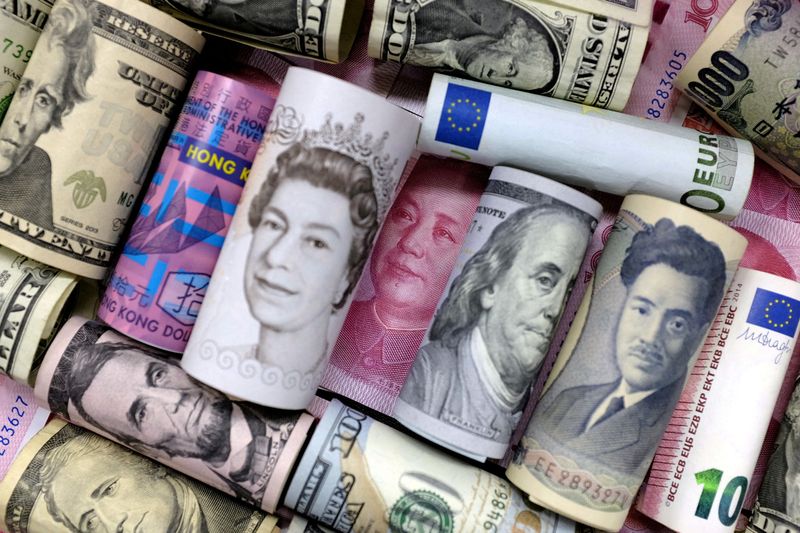By Jamie McGeever
ORLANDO, Florida (Reuters) -Asian international locations doubtlessly attach not prefer it and they no doubt did not motive it, but a ‘beggar thy neighbor’ wave of alternate rate depreciation might perhaps perhaps additionally perhaps be about to hit the continent.
If no longer a paunchy-blown forex battle, then a series of skirmishes is looming as policymakers grapple with a resurgent U.S. greenback, a fragmented G10 central bank coverage route, and a staggering breeze in the Japanese yen which appears to be like to accept as true with Tokyo’s tacit approval.
There is a total consensus that a weaker alternate rate is now no longer viewed because the appropriate lever international locations can pull to enhance economic enhance, given how deep imperfect-border provide chains and manufacturing processes fling these days when in contrast with decades long gone by.
Nonetheless extinct habits die onerous, and it is complicated to preserve some distance from a discipline the place an outsized pass in a single in every of the order’s main currencies – on this case the yen – would not build stress on the others.
While international locations might perhaps perhaps additionally fair no longer be actively looking to export their method to prosperity, seismic terms of alternate shifts in a single tend no longer to head unmatched.
Substitute charges silent subject, in particular in Asia with its prolonged history of intra-order export competitiveness. As the likelihood of more than one U.S. ardour rate cuts this 300 and sixty five days fades, Asia is feeling the squeeze from the all-extremely efficient greenback.
“There are few emerging international locations aiming for FX depreciation, but everybody is making an strive over their shoulder,” says Steven Englander, head of G10 FX strategy at Same outdated Chartered (OTC:).
“There is a limit to how worthy competitive disadvantage international locations can take, even in the occasion that they are not actively looking to create advantage from forex moves,” he adds.
JAPAN, CHINA SPILLOVERS
Many international locations in Asia might perhaps perhaps additionally perhaps be transferring nearer to those limits, effectively pushed there by about a of their G10 mates.
Any commonality between G10 central banks that can additionally fair accept as true with existed earlier this 300 and sixty five days on the 2024 ardour rate outlook is fraying, cementing the greenback’s dilemma as investors’ most favored forex.
On Tuesday afternoon Fed Chair Jerome Powell gave the clearest signal yet that the bar for rate cuts this 300 and sixty five days is rising, while that morning European Central Monetary institution President Christine Lagarde said charges it is miles going to be slice quickly.
The Swiss Nationwide Monetary institution has already broken ranks with the Fed, last month becoming the first G10 central bank to slice charges, while the Monetary institution of Japan’s absence from the FX market because the yen plummets is more conspicuous by the day.
The yen’s weak spot is a competitive advantage Asia’s second- largest economic system is getting that its regional opponents are no longer. A 25% depreciation over the last two years helped Japan preserve some distance from recession, contributing an estimated 1.4 share elements to total enhance in fiscal 2023/24.
To this level this 300 and sixty five days the yen is down 7% against the and 9% against the U.S. greenback, the currencies of its two largest export markets. It is miles the weakest in over 30 years against every and terminate to a 16-300 and sixty five days low against South Korea’s gained.
For its part, despite the indisputable truth that China’s yuan is its strongest in a 300 and sixty five days on a exact efficient alternate rate (REER) basis now, it is silent interior sight of last July’s decade low.
CONNECTION
Beijing will must variety obvious that any deterioration in bilateral U.S.-China alternate amid rising Sino-U.S. tensions and the possibility of increased tariffs and alternate restrictions is made up for in assorted places, love Europe and various Asian international locations.
Intra-regional alternate used to be about 46% of Asia’s entire alternate in 1990 and Fifty three% in 2000, in accordance with Oxford Economics. It now stands at around 60%, of which around two thirds is in intermediate goods, indisputably inputs into assorted merchandise.
This inter-connectedness dilutes the flexibility of alternate charges in imperfect-border alternate and masks the finest nature of countries’ alternate links with one yet any other.
As an instance, U.S. imports from China as a part of The US’s entire imports fell 8% over the 2017-23 period, in accordance with Oxford Economics, while the a part of imports from Europe, Mexico Vietnam, Taiwan and Korea rose.
Over the an identical period, these international locations – in particular Vietnam – all noticed imports from China as a part of entire imports upward thrust, suggesting Uncle Sam’s alternate publicity to China shifted to more indirect than insist.
Adam Slater, lead economist at Oxford Economics, is rather sanguine that Asia will come by map of the brand new FX turbulence reasonably unscathed.
“These sessions of greenback energy create strains on the margins, but unless a country has serious underlying disorders akin to poorly managed and or poorly structured debt, they doubtlessly are inclined to be less dramatic than you factor in,” he said.

A repeat of the gradual Nineties Asian FX fire storm is rarely any longer going, but that would not mean competitive FX depreciations might perhaps perhaps perhaps be ruled out, in particular with the greenback on a reputedly self-relaxing spiral increased.
(The opinions expressed listed below are these of the writer, a columnist for Reuters.)
(By Jamie McGeever; Bettering by Andrea Ricci)
FBS ForexBitcoinStock






